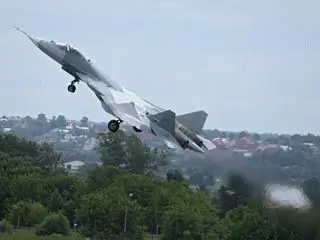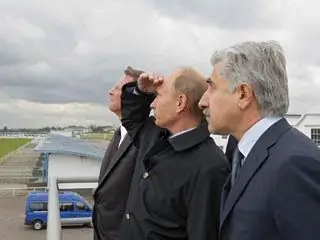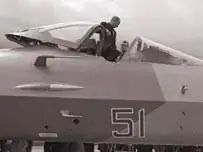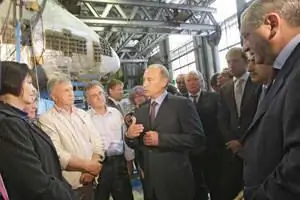- Author Matthew Elmers [email protected].
- Public 2023-12-16 21:49.
- Last modified 2025-01-24 09:17.

Prime Minister Vladimir Putin, when visiting the Central Aerohydrodynamic Institute (TsAGI) located in Zhukovsky near Moscow on Thursday, hastened to praise (see article below "Putin was shown flight of a fighter with artificial intelligence in Zhukovsky") fighter of the new fifth-generation combat aircraft T-50. The fighter, which made its 16th test flight before the prime minister, cannot yet be called a fifth-generation aircraft, experts say: in order to be called that way, it needs a different electronic filling. In the meantime, the PAK FA (Advanced Aviation Complex of Frontal Aviation) meets only some of the requirements that are put forward for machines of this class, writes "Moskovsky Komsomolets" (see article below "The outside is better than the inside").
According to experts, if an aircraft does not meet the requirements for at least two or three items on the list of qualities, it cannot be considered a representative of the fifth generation. It is for this reason that the American F-35 and the domestic MiG-35 are only budget replacements for real fifth-generation aircraft - the F-22 and T-50.
The plane shown to Putin on Thursday in Zhukovsky meets only part of the requirements. In particular, the fighter is multifunctional: it can be used both for air defense missions and for engaging ground targets. It is assumed that multifunctionality will reduce the cost of servicing the air fleet and the cost of training pilots.
On Friday, the most interesting articles on Putin's visit to Zhukovsky are covered by "Headlines" (see the article below "Vladimir Putin was shown a fifth generation fighter").
The T-50 fighter reaches supersonic speed in normal operation. Fighters of the fourth generation had to use the afterburner for these purposes. The engine on the T-50 is a digital control system and a plasma ignition system. Together with a promising airframe design, this engine gives the fighter super-maneuverability. Experts are working on the creation of a second stage engine, which will improve the aircraft's flight characteristics.
Stealth, which is a mandatory quality of the fifth generation aircraft, is only partially realized in the T-50. It should be noted that of all military aircraft developed in the Russian Federation, it is the most protected from radar detection. However, for example, the Americans, when creating the F-22, had to abandon additional maneuverability in favor of greater stealth. According to experts, Russian specialists would rather prefer maneuverability of these two qualities.
PAK FA is equipped with the latest radar with an active phased antenna array produced by the Research Institute of Instrumentation. This radar allows for a comprehensive and multichannel attack on targets, which is also a requirement for a fifth-generation aircraft.
According to experts, the T-50 still lacks the electronic filling necessary for the fifth generation aircraft. It is assumed that an aircraft of this type should have the latest avionics - a circular information system, jamming control automation, a tactical situation indicator with overlapping information received from various sources, and an automated control system. Earlier it was reported that the Indian corporation Hindustan Aeronautics Limited will develop a navigation system and an on-board computer for the T-50, which is planned to be exported.
Russian stealth is being tested with foreign avionics
According to "Nezavisimaya Gazeta" (see below article "Expensive Pleasure of the Fifth Generation"), experts generally give negative assessments of the prospects for rearmament of the army and navy. According to experts, not a single new tank or aircraft has been created in 20 years, and only one helicopter has been adopted by the Russian army. According to experts, the flight tests of the T-50 at the plant were carried out using French technology. On the prototype T-50, imported avionics were installed, the domestic one is being tested on another machine. The Russian electronic filling should replace the French one. According to experts, this will not make the T-50 cheaper than its Western counterparts.
Putin, watching the flight of the T-50 the day before, noted that the fifth-generation fighter would be 2.5-3 times cheaper than its foreign counterparts. As the prime minister noted, this will be a vehicle that will surpass the American F-22 in maneuverability, armament and range.
As Putin recalled, 30 billion rubles were spent at the first stage of the aircraft creation, and another 30 billion is needed to complete the project. Then, the aircraft engine and armament will be modernized.
The maximum speed of the PAK FA is 2600 km / h, the maximum non-afterburner speed is 2100 km / h. The practical flight range is 4300 km. The vehicle is armed with a 30-mm cannon, 8 internal suspension points and 8 external ones. For comparison: the maximum speed of the American F-22 Raptor is 2410 km / h, the maximum non-afterburner speed of this aircraft is 1963 km / h. Its practical flight range is 3219 km. The F-22 is armed with a 20 mm cannon, 8 internal suspension points and 4 external ones.
newsru.com
Putin in Zhukovsky showed the flight of a fighter with artificial intelligence

Russian Prime Minister Vladimir Putin on Thursday visited the Central Aerohydrodynamic Institute (TsAGI) in Zhukovsky near Moscow and got acquainted with the testing progress of the new fifth-generation T-50 combat aircraft developed by the Sukhoi company - it is also called an aircraft with artificial intelligence. This aircraft has a number of unique features, combining the functions of a strike aircraft and a fighter.
The aircraft is equipped with a fundamentally new avionics complex that integrates the "electronic pilot" function, and a promising radar station with a phased antenna array. This significantly reduces the workload on the pilot and allows you to concentrate on the performance of tactical tasks, reports "PRIME-TASS".
The onboard equipment of the new aircraft allows real-time data exchange with both ground control systems and within the aviation group. The use of composite materials and innovative technologies, the aerodynamic layout of the aircraft, and measures to reduce the engine's signature provide an unprecedentedly low level of radar, optical and infrared signature. This makes it possible to significantly increase the combat effectiveness in work, both for air and ground targets, at any time of the day, in simple and difficult weather conditions.
- Putin estimated the development of the Aviation Center in Zhukovsky at 11 billion rubles
The car made several circles over the airfield so that guests could fully enjoy the spectacle and evaluate the technical capabilities. The prime minister closely watched the flight, asking clarifying questions to Deputy Prime Minister Sergei Ivanov and General Director of the Sukhoi Company Mikhail Pogosyan, who were accompanying him.
Talking then with the honored test pilot of Russia Sergei Bogdan, who was flying, Putin noted that the fifth generation fighter would be 2.5-3 times cheaper than its foreign counterparts."This will be a vehicle that will also surpass our main competitor - the F-22 (USA) in maneuverability, armament and range," the prime minister said. "And fighting spirit," added the pilot. "First of all," Putin agreed.
The head of government recalled that at the first stage of creating the aircraft, 30 billion rubles were spent, to complete the project another 30 billion is needed. Then the modernization of the engine, weapons, etc. will begin. "This product has a long manufacturing life and a long service life," Putin noted. "It will serve 30-35 years in service, taking into account modernization."
Sergei Bogdan told the Prime Minister that today's test flight of the unique fighter was the 16th in a row, and several more sorties are expected in the near future.
After a short conversation, the prime minister and the pilot proceeded to the fighter plane, and Putin climbed into the cockpit. Bogdan explained in detail to the premier the peculiarities of the machine, drawing his attention, in part, to a system that allows the pilot to control the main systems of the aircraft without removing his hand from the handle. According to him, this is especially important for a pilot during overloads. "I know, I flew," Putin said in response.
The first flight of the fifth generation fighter took place on January 29 this year in Komsomolsk-on-Amur at the airfield of the aviation production association, which is part of the Sukhoi holding. The car remained in the air for 47 minutes. Then the fighter was also piloted by Sergei Bogdan.
On April 29, a program of preliminary tests of the aircraft began at the Gromov Flight Research Institute in Zhukovsky near Moscow. Today, the degree of development of the aircraft and its systems in terms of reliability and safety allows to ensure the implementation of the flight test program in full, Interfax reports, citing the holding's press service.
Prior to that, Putin examined the Central Aerohydrodynamic Institute. He began his visit to the laboratory, where the T-128 transonic wind tunnel was installed, with the help of which models of aircraft and rockets are studied. In it, in particular, models of such aircraft as Sukhoi Superjet 100, MS-21, Tu-204, as well as military Su-27, MiG-29 and the fifth generation T-50 aircraft were studied. In addition, a number of foreign aircraft were studied here, in particular, the Boeing and Airbus models.
As the head of the laboratory Anton Gorbushin told RIA Novosti, there are only 11 such wind tunnels in the world, of which only two are larger than the Russian one. However, as experts say, the quality of the flow in the T-128 is the highest - due to the uniformity, low turbulence and the ability to change the speed and density of the flow. The pipe was built in 1983 and would have cost $ 1 billion to build at today's prices.
During his visit to the laboratory, TsAGI General Director Boris Aleshin demonstrated to the premier the models of Russian aircraft that are being tested here. In particular, aluminum models of the Sukhoi Superjet 100, Sukhoi Superjet 130 and MS-21 aircraft were presented. Putin drew attention to the MC-21 model and asked how many passengers such an aircraft would carry. Aleshin replied that the vehicle would be capable of taking on board 180 people.
According to the general director, the institute is currently conducting research and development of promising aircraft, which should appear by 2020-2025. Aleshin noted that these aircraft, in comparison with the current ones, will have a two-fold reduction in emissions and noise levels. In addition, the new aircraft will have a slightly different wing and fuselage design.
The development of the Aviation Center in Zhukovsky was estimated by Putin at 11 billion rubles
In turn, the head of government promised to allocate 11 billion rubles from the budget until 2012 for the development of the Aviation Center in Zhukovsky. Of these, 4 billion will go to the development of the city's infrastructure. Another 1 billion rubles will be allocated to finance TsAGI itself, Putin said.
He stressed that today this unique institute, which is engaged in testing aircraft equipment, as well as various complex structures, is working steadily. "In 2009, TsAGI fulfilled orders for 3.2 billion rubles, and this year it has already been loaded for 4 billion," the prime minister said.
Putin also said that the long-term plans for the development of TsAGI include the creation of three new powerful wind tunnels. "But this is already separate money. About 60 billion rubles. They will not be allocated in one year. We must understand what is the priority here," he said.
The head of government stressed that the creation of the Aircraft Building Center in Zhukovsky will have a positive effect on the city itself, in particular, on its infrastructure.
At present, TsAGI is the world's largest center for aviation science, where concepts for advanced aircraft are developed and comprehensive research is carried out in the field of aviation, rocket and space technology. The Institute has a unique experimental base that meets the highest international requirements. TsAGI conducts a state examination of all Russian aircraft and gives a final conclusion on the safety of the first flight.
newsru.com
Better outside than inside
PAK FA lacks hardware to become the world's most advanced aircraft
The PAK FA (Advanced Aviation Complex of Frontline Aviation), which has made its 16th test flight in front of the Prime Minister today, with all its undoubted advantages, cannot yet be called a fifth generation fighter.

When in the late 70s of the last century in the United States and the USSR they began to form the concept of flying combat vehicles of the future, in both countries, the first thing they did was to draw up lists of requirements for such fighters. Experts around the world agree on one thing: if a car does not meet the requirements for at least two or three items of such a list, then it cannot be considered a representative of the fifth generation.
Just because of this discrepancy, the American F-35 and the domestic “MiG-35” are only budget replacements for real fifth-generation aircraft: the F-22 and the aircraft that the PAK FA will eventually become.
In the meantime, the domestic development, shown to the distinguished guests on Thursday in Zhukovsky, meets only part of the requirements.
This fighter is multifunctional. It can be used both as a means of gaining air supremacy, and for performing air defense missions, and for engaging ground targets. In the long term, the versatility of this approach will reduce the cost of servicing the air fleet and the cost of training pilots, not to mention the convenience of tactical use.
Fighter of the fifth generation reaches supersonic speed in normal operation of the engines. Fighters of the fourth generation had to turn on the afterburner to cross the sound barrier. The engine installed on the PAK FA produced by NPO Saturn, despite being similar to the engines of the previous generation, has significant differences. This is primarily a digital control system and a plasma ignition system. Together with a promising airframe design, this engine gives the fighter super-maneuverability, and this is another requirement for fifth-generation aircraft. It should be noted that the plans already include the creation of a second stage engine, which will further improve the flight characteristics of the future aircraft.
The T-50's stealth remains a controversial issue. Undoubtedly, of all military aircraft developed in our country, this one is the most protected from radar detection. However, when creating the F-22, the Americans had to abandon additional maneuverability in favor of greater stealth. It is believed that domestic developers will make the opposite choice - domestic fighters traditionally win in maneuverability and lose in stealth.
PAK FA is also equipped with the latest radar with an active phased antenna array produced by the Research Institute of Instrumentation. This radar allows you to conduct a comprehensive and multi-channel attack on targets. Thus, one more requirement for the fifth generation aircraft has been fulfilled.
As for another basic requirement - advanced avionics (circular information system, jamming control automation, tactical situation indicator with overlapping information received from different sources, automated control system), the data on it either remains classified or is too sparse to do any or conclusions. Most likely, it is the electronic filling that the T-50 still lacks to be called a fifth generation fighter.
By the way, it was previously reported that the Indian corporation Hindustan Aeronautics Limited will develop a navigation system and an on-board computer for the export version of the T-50.
The declared characteristics of the PAK FA
Crew: 1 person.
Length: 20.4 meters.
Wingspan: 14.7 meters.
Maximum takeoff weight: 35 480 kg.
Top speed: 2600 km / h.
Maximum non-afterburner speed: 2100 km / h.
Practical range: 4300 km.
Service ceiling: 20,000 meters.
Armament: 30-mm cannon, 8 internal points of suspension and 8 external.
F-22 Raptor specifications
Crew: 1 person.
Length: 18.9 meters.
Wingspan: 13.5 meters.
Maximum takeoff weight: 38,000 kg.
Top speed: 2,410 km / h.
Maximum non-afterburner speed: 1963 km / h.
Practical range: 3219 km.
Service ceiling: 19,812 meters.
Armament: 20 mm cannon, 8 internal points of attachment and 4 external ones.
mk.rul
Vladimir Putin was shown a fifth generation fighter

Yesterday, June 17, Prime Minister Vladimir Putin visited Zhukovsky near Moscow, where he examined the Central Aerohydrodynamic Institute (TsAGI). Putin was shown the fifth generation T-50 fighter, which is now undergoing flight tests. The head of government was accompanied by Deputy Prime Minister Sergei Ivanov and Governor of the Moscow Region Boris Gromov.
Rossiyskaya Gazeta writes that the general director of TsAGI Boris Aleshin told the prime minister about the history of the institute and showed the T-128 transonic tube. The 100 MW structure is intended for studies of aerodynamic characteristics and aeroelasticity of aircraft models. The conditions are as close as possible to the flight conditions. The head of the laboratory, Anton Gorbushin, said that this is the largest pipe in the Eastern Hemisphere ("Fighter with the mind").
The prime minister promised the TsAGI staff that next year the institute would receive a billion rubles from the budget. Another 4 billion will go to roads and other infrastructure. After that, Putin and his entourage went to watch the 16th test flight of the new fighter. Then the prime minister succumbed to temptation and looked into the cockpit of the landing fighter. Writes about this "Moskovsky Komsomolets" in the article "Premier in the fifth generation."
Vremya novostei notes that, according to the prime minister, about 30 billion rubles were spent in the first stages of the fighter's creation, and about the same amount will be needed to complete the project. Putin told the audience that the new plane would last 30-35 years. In addition, it will cost 2, 5-3 times cheaper than foreign counterparts (“I know, I flew”).
Independent experts, however, do not share the prime minister's enthusiasm. They give generally negative assessments of the prospects for rearmament of the army and navy. Twenty post-Soviet years have passed practically in vain for the country's Armed Forces, says Anatoly Tsyganok, head of the Center for Military Forecasting. During this time, not a single new tank or aircraft was created. Only one helicopter was adopted. As for the T-50, it is known that flight tests at the plant were carried out using French technology. Imported avionics installed on the T-50 prototype provided airframe testing, while the domestic one was tested on a different machine. In the future, Russian avionics will replace the French, but this is unlikely to make the new machine cheaper than its Western counterparts. Nezavisimaya gazeta writes about this in the article “Expensive Pleasure of the Fifth Generation”.
zagolovki.ru
Expensive fifth generation pleasure
Vladimir Putin is ready to invest budgetary funds in the future of the Russian Air Force

Yesterday Prime Minister Vladimir Putin visited the Central Aerohydrodynamic Institute (TsAGI) in Zhukovsky near Moscow, where he was shown a fifth-generation T-50 fighter. The novelty of the Russian military-industrial complex and almost the only hope of the country's air force is undergoing flight tests today. Until June 17, the plane made 15 flights, successfully overcoming the important psychological milestone of the devil's dozen in 13 flights, which are watched with superstition by the designers and pilots. Yesterday, the T-50 was lifted into the sky for the 16th time in the presence of the head of government.
Until 2012, about 11 billion rubles will be allocated from the budget for the development of the Aviation Center in Zhukovsky near Moscow, Vladimir Putin said yesterday. At the same time, 1 billion rubles are allocated to finance the TsAGI itself. The prime minister noted with satisfaction that the institute, which is engaged in testing aircraft, as well as various complex structures, is working steadily. He also said that the long-term plans for the development of TsAGI include the creation of three new powerful wind tunnels. “But this is already separate money. About 60 billion rubles. They will stand out in more than one year. We must understand what is the priority here,”the prime minister said.
Then he was shown the famous T-50 - the future of the Russian Air Force. Flight tests of this fifth generation fighter are proceeding on schedule. True, it is not known for certain whether this schedule took into account Vladimir Putin's yesterday's visit. But the first flight of the T-50 took place on January 29, 2010 at the factory airfield of the Komsomolsk-on-Amur aviation production association. Then the fighter spent 47 minutes in the air. Now the flight time counts down to the clock, but so far it cannot be said that the "newborn" is firmly on his feet. However, the testers do not have much time - serial deliveries of the T-50 will begin in 2015. By that time, the new aircraft will probably have a more euphonious name that will not be so directly associated with tanks. The first fighters should arrive at the Lipetsk Center for Combat Use and Flight Personnel Retraining in 2013.
It is believed that with the creation of the T-50, the Russian aircraft industry and related industries will confirm the entry to a qualitatively new technological level. The vehicle will be equipped with a fundamentally new avionics complex, a phased array radar. The use of composite materials and innovative technologies has provided a modern aerodynamic layout of the aircraft, a record low level of radar, optical and infrared visibility.
Another gift for the Russian Air Force is being prepared by the Taganrog Aviation Technical Complex, where the start of work on a new reconnaissance aircraft was announced recently, which will eventually replace the fleet of A-50 aircraft. In metal, the novelty, created on the basis of the Il-76MD, will appear in two years. To date, the development of documentation has been completed and preparations are underway for production for construction. The reconnaissance aircraft should significantly surpass the modernized A-50U and even more so the export analogue of this aircraft, known as the A-50EI.
It should be said that independent experts have no special reverence for ceremonial reports from assembly lines and design bureaus of Russian defense enterprises, giving generally negative assessments of the prospects for rearmament of the army and navy. Twenty post-Soviet years have passed practically in vain for the country's Armed Forces, says Anatoly Tsyganok, head of the Center for Military Forecasting. During this time, not a single new tank or aircraft was created. Only one helicopter was adopted. “Military equipment is in the corral. Russia is 20 years behind the West and the United States,”the analyst emphasized, recalling that the Americans created their fifth generation aircraft 18 years ago.
As for the T-50, then, according to Tsygank, due to the secrecy of information, the nuances of this project are not widely discussed. However, it is known that flight tests at the plant were carried out using French technology. Imported avionics installed on the T-50 prototype provided airframe testing, while the domestic one was tested on a different machine. In the future, Russian avionics will replace the French, but this is unlikely to make the new machine cheaper than its Western counterparts. “Aircraft of the fifth generation are very expensive machines. If we look at the aggregate prices, the costs of their development and production are approximately the same for both Russia and the United States,”Tsyganok summed up.
By the way, the Americans did not afford such expenses. As a result, the number of fifth-generation aircraft in the US Air Force today is almost four times lower than the original plan - not 280, but only 80 aircraft. How many T-50s will ultimately be affordable for the RF Ministry of Defense, time will tell. And the fact that possessing a fifth-generation fighter is an expensive pleasure was also confirmed by Putin. According to him, the completion of work on this machine will require about 30 billion rubles. This is in addition to the 30 billion rubles that have already been spent on the first stage of the aircraft creation.
ng.ru






